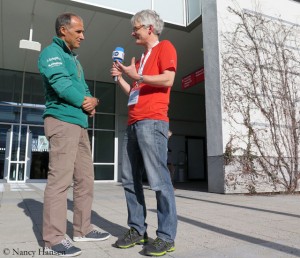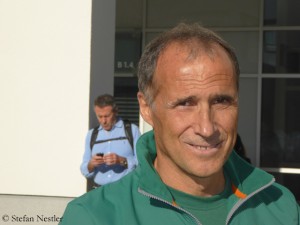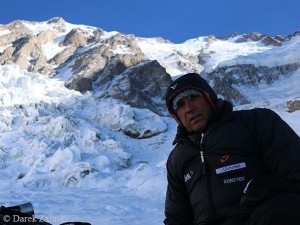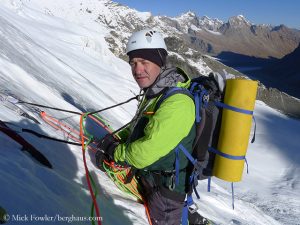Dujmovits: “Everyone wants to be the first on Nanga Parbat”
Ralf Dujmovits is one of the many climbers who have already failed in winter on Nanga Parbat. The first and so far only German who climbed all 14 eight-thousanders tried to scale the 8,125-meter-high mountain in Pakistan at the turn of 2013/2014 after having acclimatized previously on the 6,962-meter-high Aconcagua, the highest mountain in South America. At that time Ralf abandoned his expedition relatively quickly because he thought the danger of ice avalanches on the Messner route was by far too high. I met the 54-year-old this week at the trade fair ISPO in Munich.
Ralf, at the moment much is happening on Nanga Parbat. Are you not itching to go there again?
Of course, I am itching, but I also know how cold, hard and difficult the times on Nanga Parbat can be. In this respect I am quite happy that I enjoyed the winter in the south while climbing. [Ralf returned mid-January with his partner, the Canadian climber Nancy Hansen, from a trip to Southeast Asia]. Despite everything, I’m itching so much that we consider going there again next winter. I would very much just like to use my experiences that I made on Nanga Parbat for an – in the ideal case successful – winter ascent.
But you would have to be prepared for the fact that you would be anything but alone on the mountain. It feels as if Nanga Parbat in winter becomes more and more attractive for professional climbers each year.
It’s whipping up. K 2 and Nanga Parbat are the only eight-thousanders, which have not yet been climbed in winter. Of course, many mountaineers want to try it. I think it’s good if you do it with a lot of experience, even in climbing Nanga Parbat in summer. Then you already know where to go and what to expect. In this respect, I think I would have good cards – if the conditions on the mountain permit.
This winter, many experienced climbers are trying to scale Nanga Parbat, even with winter experience on this mountain. To look no further than Tomek Mackiewicz, who was there the sixth winter in a row, or even Simone Moro, a very experienced winter climber. Nevertheless, Nanga Parbat remains a hard nut to crack. Why is it so difficult to climb this mountain in winter?
I think, the main mistake is trying to climb Nanga Parbat insufficiently acclimatized. Last week there was a relatively long good weather window but once again it was not used. There are some climbers who had a good pre-acclimatization on 6000-meter-high mountains. Despite everything, I believe that the acclimatization is not sufficient to be able to ascend as quickly as possible. There’s the rub. When the rare good weather windows are used for acclimatization, essential time is lost.
This year again, some teams tried to climb variants of existing routes like the Schell route or the Messner route. Which route do you think has the best chances of succeeding?
I still believe that a winter ascent on the Rupal side is not possible because the route leads to the Mazeno Ridge from where it’s still a long way to the top. You have to make a very long traverse towards the summit trapezoid. There is almost always in winter consistently black ice. You simply need too much time for this traverse at high altitude. If at all, you will have the best chances to succeed on the Diamir side. The Messner route, on the far left side of the Diamir flank, is probably the most promising. Or the very classic Kinshofer route that, however, needs to be secured with fixed ropes because it is very steep in long areas and thus has black ice in winter.
You said you are flirting with the idea of returning to Nanga Parbat next winter. Will your motivation be gone, if someone should succeed climbing it for the first time this winter?
Of course, for all who are now on Nanga Parbat a dream would come true to be the first ever at the summit in winter. They would kid themselves denying it. I already stood on top of Nanga Parbat, I know the mountain well, I need not necessarily to reach the summit a second time. If I try it again in winter, I’ll focus on being the first to do it. If someone was successful this winter, I probably would not go there anymore.
 In this case, you could go to K 2.
In this case, you could go to K 2.
I think I am beyond the age to tackle K 2 in winter. K 2 is at least one dimension more difficult than Nanga Parbat. And if so many climbers find Nanga Parbat a hard nut to crack, then all the more it will be much, much more extreme on K 2.
Mount Everest is even higher. Did you finally give up your ambition to climb it without bottled oxygen?
I take an Everest sabbatical in 2016. [In 1992, Mount Everest was the only eight-thousander, where Ralf was using a breathing mask. Since then he tried seven times in vain to scale the highest mountain on earth without bottled oxygen.] But we plan to go there again in 2017. I have still not banished the thought of climbing Everest without bottled oxygen.
You have an Everest break, but for sure other ideas for this year?
I have other plans. There are seven-thousanders which are still unclimbed. One of them is located in Pakistan. We would like to climb it in June.
Will you tell us, which one?
No, we actually don’t want to give details by now.










